City of Enterprise
Virtute et Industria. Virtue and diligence. If Bristol's motto sounds a little stodgy, nothing could be further from the truth. This is the city that nurtured the genius of Isambard Kingdom Brunel, sent John Cabot on his way to the ends of the earth 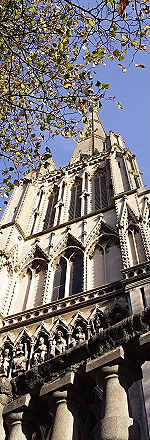 and fostered countless other examples of enterprise, discovery and innovation. The tradition continues today in the studios of Aardman Animations, at the prestigious Wildscreen festival (whose Panda awards are the Oscars of wildlife filming), and in the laboratories of the University of the West of England, where cutting-edge robotics could one day change our lives. And, of course, at the very time that the rusting shell of Brunel's magnificent SS Great Britain was limping home from the Falkland Islands in 1970, Concorde was testing the skies.
and fostered countless other examples of enterprise, discovery and innovation. The tradition continues today in the studios of Aardman Animations, at the prestigious Wildscreen festival (whose Panda awards are the Oscars of wildlife filming), and in the laboratories of the University of the West of England, where cutting-edge robotics could one day change our lives. And, of course, at the very time that the rusting shell of Brunel's magnificent SS Great Britain was limping home from the Falkland Islands in 1970, Concorde was testing the skies.
Yet despite its illustrious heritage, Bristol doesn't shout its credentials from the rooftops. In fact, in some ways it doesn't feel like a city at all. Take a walk on the rolling Downs and look across the Avon Gorge to the blue hills of Somerset, and the bustle of the centre could be a hundred miles away. It is an experience you can repeat in the numerous other expanses of green that bring a breath of fresh West Country air to urban living.
This laid-back feel is reinforced by the absence of a single, coherent focal point. True, there are some glorious big set pieces. Clifton Suspension Bridge is the most famous, Brunel's "first child and darling" although he never lived to see its completion. The medieval cathedral is another and if you are interested in ecclesiastical architecture, you won't want to miss St Mary Redcliffe Church, described by Queen Elizabeth I as "the fairest, goodliest, and most famous parish church in England". But for the most part, Bristol unfurls its treasures slowly, uphill and down dale, like a rumpled patchwork quilt with pockets of history sewn into the creases.
That even applies to the centre. For although its historic heartwas shattered by the Blitz, evocative remnants remain, 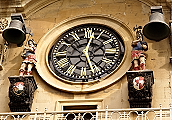 hiding behind concrete blocks thrown up in post-war haste. Topped by the medieval spire of St John's Church, the only surviving city gate leads into Broad Street, past Edward Everard's exuberant Art Nouveau printing works to Christ Church, whose colourful 18th-century quarter jacks still strike the quarter hour. This in turn brings you to Corn Street, hub of commercial life for centuries. The graceful Palladian-fronted Exchange, designed by John Wood the Elder, houses a lively market which spills onto the pavement at weekends and every Wednesday, when the farmers' market comes to town. Standing before it are the Nails, four flat-topped bronze pillars where merchants spread out samples for inspection and buyers laid down their cash, hence the expression 'to pay on the nail'.
hiding behind concrete blocks thrown up in post-war haste. Topped by the medieval spire of St John's Church, the only surviving city gate leads into Broad Street, past Edward Everard's exuberant Art Nouveau printing works to Christ Church, whose colourful 18th-century quarter jacks still strike the quarter hour. This in turn brings you to Corn Street, hub of commercial life for centuries. The graceful Palladian-fronted Exchange, designed by John Wood the Elder, houses a lively market which spills onto the pavement at weekends and every Wednesday, when the farmers' market comes to town. Standing before it are the Nails, four flat-topped bronze pillars where merchants spread out samples for inspection and buyers laid down their cash, hence the expression 'to pay on the nail'.
Commerce has always been the lifeblood of Bristol since Saxon settlers chose this strategic location on the rivers Avon and Frome a few miles from the sea. By the Middle Ages its ships were sailing as far afield as Portugal and Iceland, in the 17th and 18th centuries it was at the forefront of trade with the New World. This was its golden age and the legacy remains in some beautiful architecture. Queen Square, one of the earliest and largest residential squares in England, is a very fine example. 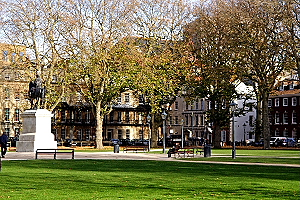 But the pièce de résistance is surely Clifton Village, which combines Georgian elegance with a spectacular setting as it tumbles higgledy-piggledy downhill from its perch above the river.
But the pièce de résistance is surely Clifton Village, which combines Georgian elegance with a spectacular setting as it tumbles higgledy-piggledy downhill from its perch above the river.
If the fruits of Bristol's mercantile past are easy to spot, its maritime heritage is more elusive. As you emerge from Corn Street onto the Centre, it is hard to believe that you are walking on the very spot where tall ships once moored before this stretch of the Frome disappeared below concrete. Turn the corner into King Street, however, and you still catch a whiff of those seafaring days. First you come to the pink-washed Merchant Venturers' Almshouses, founded in 1554 for retired sailors. Further along, two 17th-century taverns look across the cobbles to the Theatre Royal, Britain's oldest working theatre. And right at the end, where the street joins the ancient quayside of Welsh Back, the timber-framed Llandoger Trow could come straight from the pages of Treasure Island. Which may well be the case, since it was from Bristol that R. L. Stevenson's heroes set sail and the Hole in the Wall pub by Queen Square fits his description of the Spyglass Inn to a T.
This is by no means the city's only claim to literary fame. Robert Southey and Thomas Chatterton were born here, Samuel Taylor Coleridge and William Wordsworth were regular visitors and it was local printer Joseph Cottle who published the first edition of Lyrical Ballads, containing Tintern Abbey and The Rime of the Ancient Mariner. Back on the nautical theme, the extraordinary rescue of castaway Alexander Selkirk by a Bristol privateer and his navigator-cum-pirate, William Dampier, inspired Daniel Defoe to write Robinson Crusoe. And Dampier's swashbuckling round-the-world travel tales clearly had an influence on Jonathan Swift's Gulliver's Travels.
Privateering. Press gangs. Piracy. The city's days of glorious prosperity had their darker side. Most cruel of all was the lucrative trade in human beings, for the great ships that brought home sugar, tobacco, cocoa and rum also transported an estimated 500,000 West African slaves to the British-owned islands of the Caribbean. You will find reminders at the Georgian House just off Park Street, former home of plantation owner John Pinney and his black manservant Pero. For a deeper understanding, the award-winning British Empire and Commonwealth Museum in Brunel's Grade 1-listed building at Temple Meads station tells the story of British imperialism, warts and all, from 1497 to the present day.
For Bristolians, 1497 is a very significant date. That was the year John Cabot became the first European to set foot on mainland America, paving the way for others to follow. 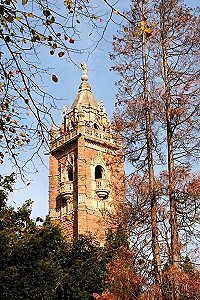 400 years later a tower was erected in his honour on Brandon Hill and is now one of Bristol's best-loved landmarks. In 1997 a band of enthusiasts marked the 500th anniversary with equal panache. Not only did they build a replica of Cabot's tiny, square-rigged caravel, they took her across the Atlantic in a re-run of his epic voyage.
400 years later a tower was erected in his honour on Brandon Hill and is now one of Bristol's best-loved landmarks. In 1997 a band of enthusiasts marked the 500th anniversary with equal panache. Not only did they build a replica of Cabot's tiny, square-rigged caravel, they took her across the Atlantic in a re-run of his epic voyage.
Today the Matthew is moored beside that other great icon of maritime achievement — SS Great Britain, now lavishly restored complete with first-class dining saloon, ladies' boudoir and a working reproduction of the original engine. Ironically, the revolutionary design of Brunel's grand liner helped to hasten Bristol's demise as an international port. For as ships grew ever larger the vast ebb and flow of the tidal harbour became an increasingly serious handicap. The creation of a "floating harbour" in 1804 eased the situation for a while and Brunel himself designed a system of silt-clearing sluices that still operates today. But nothing could be done about the tortuous approach through the narrow Avon Gorge. Between 1877 and 1908 new docks were built at the mouth of the river and another appeared in 1977. After centuries of continuous bustle the city's harbourside fell silent.
But not for long. The cultural venues of the Arnolfini, the Watershed and the Industrial Museum were the first to move in followed in recent years by a string of lively restaurants, nightclubs and bars. Pleasure craft and houseboats line the quayside, brightly-painted ferries ply up and down taking commuters to work and giving tourists a fresh perspective on the city. 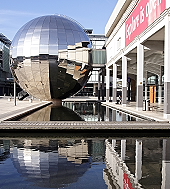 The year 2000 saw the opening of an innovative science centre overlooking the chic water features of Millennium Square. There is more to come as the redevelopment of Canon's Marsh a few yards downstream gathers pace.
The year 2000 saw the opening of an innovative science centre overlooking the chic water features of Millennium Square. There is more to come as the redevelopment of Canon's Marsh a few yards downstream gathers pace.
It is not the only change on the horizon. Opening this autumn, the new £500million shopping and leisure complex of Cabot Circus promises to catapult Bristol into the premier league of retail centres. Meanwhile the area around Temple Meads is being completely remodelled and the city's main concert venue, the Colston Hall, is in the throes of a stylish new makeover. The Industrial Museum is also being transformed and when it re-emerges in 2011 as the Museum of Bristol it will explore the story of the city's past and present, its people, its essence. It should make for a fascinating visit. Virtute et Industria. Bristol's spirit of enterprise lives on.
DID YOU KNOW?
- The Corn Exchange clock has two minute hands. The extra one shows 'Bristol' time, a reminder of the days before British clocks were standardised and the city lagged ten minutes behind London.
- Royal York Crescent in Clifton is reputedly the longest crescent in Europe.
- At night a beacon on the spire of Cabot Tower flashes messages in Morse code.
- Before the floating harbour was built, ships had to be exceptionally strong and their cargoes securely loaded to withstand the stress of being beached at low tide. This gave rise to the expression "shipshape and Bristol fashion".
- Humphry Davy, inventor of the miner's safety lamp, experimented with nitrous oxide in a Bristol laboratory. After observing the effects on himself and his friends, he coined the term "laughing gas".
- The Plimsoll line, lead shot and perhaps even blankets are just three creations we owe to former inhabitants of the city.
Magic Mull Holiday Cottages
Catalan canvas French magazine